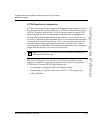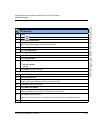
Network Settings
41-001160-00, Release 2.1, Rev 04 4-31
Configuring Network and Session Initiation Protocol (SIP) Features
Configuring the IP Phones
Virtual LAN (optional)
Virtual Local Area Network (VLAN) is a feature on the IP phone that allows for
multiple logical Ethernet interfaces to send outgoing RTP packets over a single
physical Ethernet as described in IEEE Std 802.3. On the IP phone, you configure
a VLAN ID that associates with the physical Ethernet port.
By configuring specific VLAN parameters, the IP phones have the capability of
adding and removing tags, and processing the ID and priority information
contained within the tag.
VLAN on the IP phones is disabled by default. When you enable VLAN, the IP
phone provides defaults for all VLAN parameters. If you choose to change these
parameters, you can configure them using the configuration files, the IP Phone UI,
or the Aastra Web UI.
The following sections describe the VLAN features you can configure on the IP
phones.
Type of Service (ToS), Quality of Service (QoS), and DiffServ QoS
ToS is an octet as a field in the standard IP header. It is used to classify the traffic
of the different QoSs.
QoS provides service differentiation between IP packets in the network. This
service differentiation is noticeable during periods of network congestion (for
example, in case of contention for resources) and results in different levels of
network performance.
Port 0 is the Ethernet LAN Port connected to the network. Port 1 is the Ethernet
PC Port used for passthrough to a PC.
Differentiated Service (DiffServ) QoS is class-based where some classes of traffic
receive preferential handling over other traffic classes.
The Differentiated Services Code Point (DSCP) value is stored in the first six bits
of the ToS field. Each DSCP specifies a particular per-hop behavior that is
applied to a packet.
Note: All latest VLAN functionality is backwards compatible with IP
Phone Releases 1.3 and 1.3.1.


















